Adaptation for students in mainstream schools who may benefit from AAC
Author: Marion Stanton
Pre-requisites to learning:
It is important that students who rely on AAC have access to textbooks, teacher’s PowerPoints, worksheets, and any other materials that their peers have access to. They need independent means to engage with learning materials so that their learning can develop through repetition with variety, reminders, and practice. Finally, they need a means to record their answers.
This is best achieved using an on-screen keyboard with word-prediction making the learning of literacy essential. However, symbol-based vocabularies and/or answers from multiple choice options may also be appropriate. Multiple choice particularly enables the student to keep up with the pace of the classroom.
The aim is to for the student to achieve maximum independence in the most time effective manner exerting the least physical effort. Once a student’s access is optimised, we can be surprised by how much they can achieve. They key to supporting students who rely on AAC is to ensure that their working memory is optimised. Working memory is the facility we all use to manipulate information to arrive at an answer. It only lasts approximately 15 seconds for any of us, so it is crucial that a student is only expected to have a maximum of 15 seconds thinking time for each question or part of a question they are working on. An example would be a two-stage mental arithmetic sum such as 10-5+2=7. The student needs to take 5 from 10 but they also need to hold +2 in their working memory to retrieve and answer.
Long-term memory is where we store what we remember without having to think. An example of this is committing the times tables to memory. However, to achieve this a non-disabled student will, for 10×10 multiplication table spend anywhere between 20 hours and 200 hours, spread out over the course of 1 to 5 years of regular “drilling”, which should really be a combination of instant recall, finding shortcuts, and speed training . It is highly likely that this would be a significant challenge for a student who relies on AAC so it could be argued that having a multiplication table to consult or a calculator is a reasonable adjustment for students who rely on AAC.
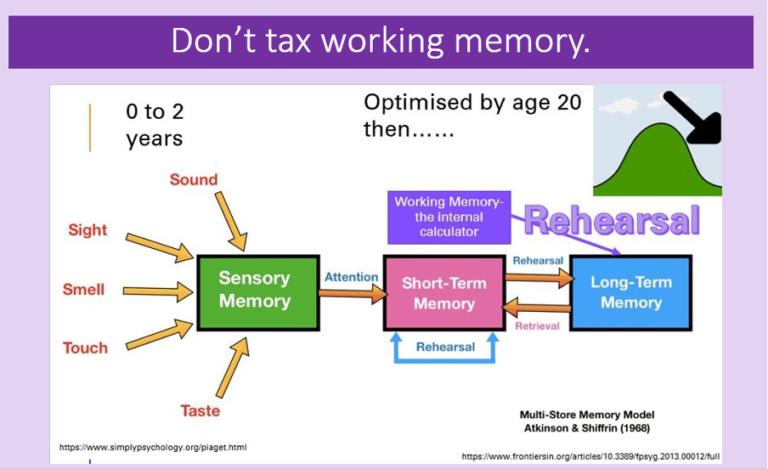
Working memory is compromised by the need to use AAC as it is a much slower process than speech or free writing. It is therefore essential that students who rely on AAC are given ways of working that mitigate against this as much as possible.
Many schools provide support to AAC reliant students by adding lists of words to their communication pages. Whilst this may be helpful when the student wishes to talk about what they are learning, it is far from adequate in supporting learning outcomes. For this to be possible students need access to the source information that they are learning from, activities that give them practice with the source information and a means to record answers to questions in the same way as their non-disabled peers. We call these three phases of learning input, elaboration, and output. Access to resources in these three phases should be provided in a manner that ensure that the student experiences no disadvantage as compared to the access that their non-disabled peers are entitled to. For this to be possible resources need providing so that the student is required to exert the least possible physical effort in the timeliest manner achievement with maximum independence. This is to ensure that a student’s working memory is not compromised by difficulty with access to learning.
More about the three phases of learning:
The examples in the following section are taken from CandLE’s advanced accredited courses which would be equivalent to the higher levels of a formal curriculum or a mix of key stages 2 and 3.
The input phase:
This is the phase where the teaching is provided to the student either through direct teaching instruction or through their own research of a topic. Examples of ways in which students gather information include:
• Teacher presentations to one or more students using PowerPoint or other presentation software.
• Video presentations.
• Internet Research.
• Textbooks
• Handouts
Any information that a non-disabled student can independently access must also be available for the student who uses AAC to access the same materials on their AAC devices.
Here are some examples of independent access to information:
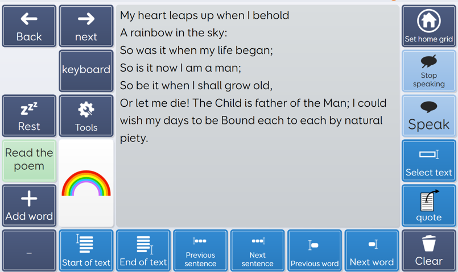
In this example the student can listen to the poem they will be working with as often as they wish to and isolate pieces of text to quote from.
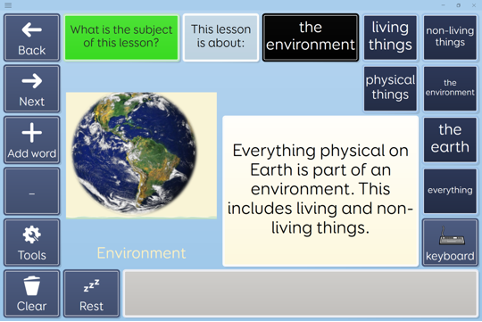
This is an example of a teacher presentation adapted for a student to access on their AAC device.
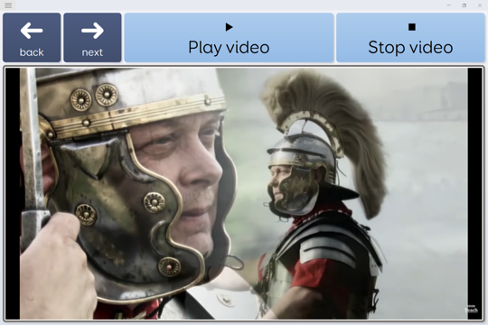
This is an example of a video that has been made available to a student on their AAC device. Having the video on their own device means that the student can independently access the source as often as they need in the most accessible way possible.
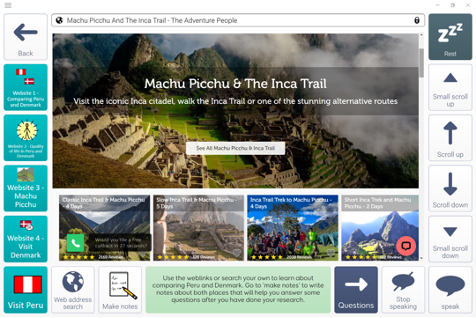
This is an example of an adaptation in a student’s AAC device enabling them to carry out internet research independently.
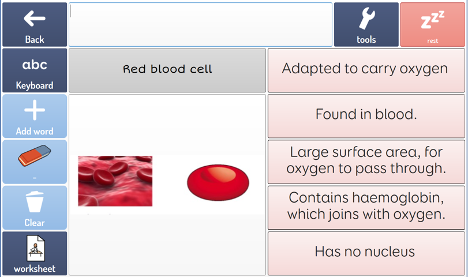
Here is an example of an adaptation of a page from a textbook with the key information provided in small chunks so that each piece of information is easily understood.
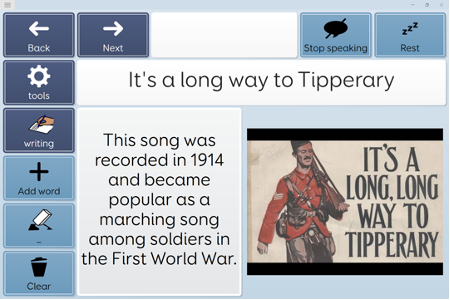
Here is an example of a handout that has been adapted for the student to access in their AAC device.
The elaboration Phase:
This phase of learning is where the student consolidates their understanding by carrying out activities, making predictions, highlighting relevant pieces of text and discussing the topic.
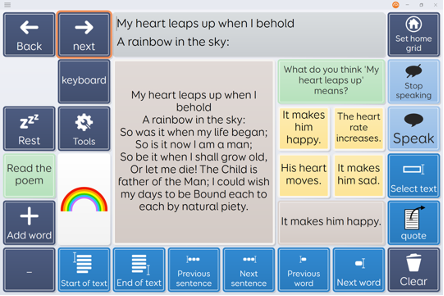
In this example the student is answering a multiple-choice question about a meaning in the poem.
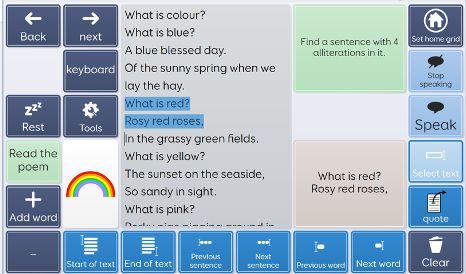
In this example the student is highlighting text to answer the question.
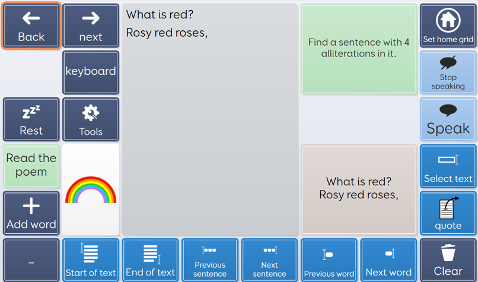
Following on from highlighting the text the student can use their AAC software to create a quote from the text to answer the question.
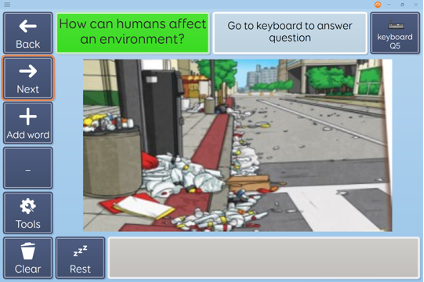
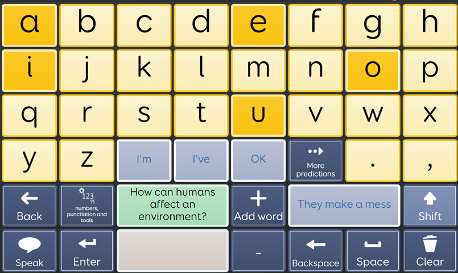
In the above example a student is using the keyboard in their AAC device to answer a question about the effect humans have on the environment using a picture prompt.
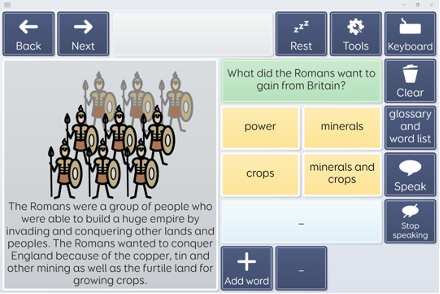
In this example the student is able to refer to the information from the textbook to answer a multiple-choice question on the same page.
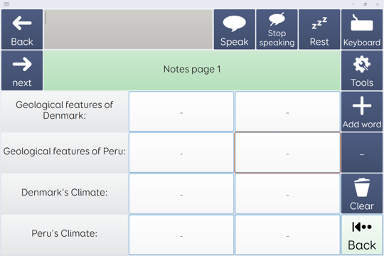
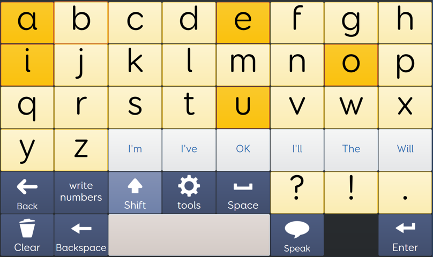
In this example the student is making notes from the website that they have visited.
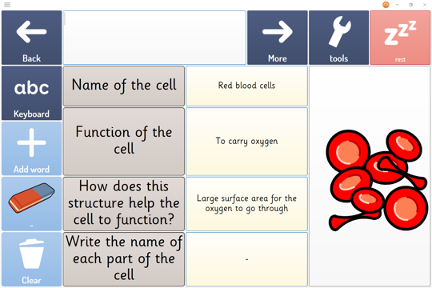
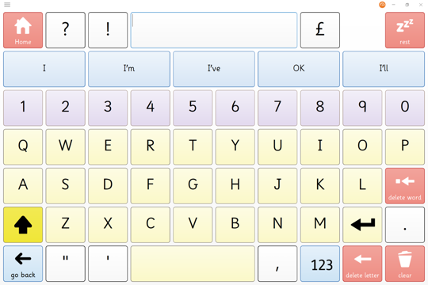
In the above example the student has had a worksheet adapted on their AAC device so that they can type answers to the questions.
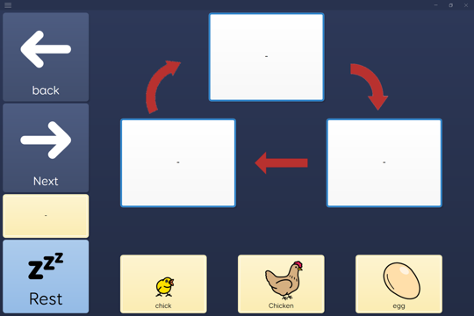
This is an example of a labelling exercise to consolidate learning on life cycles.
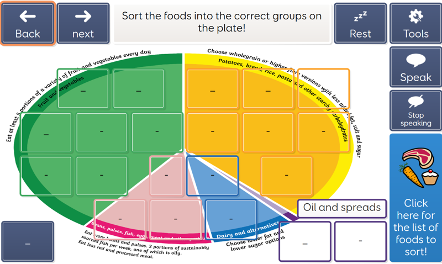
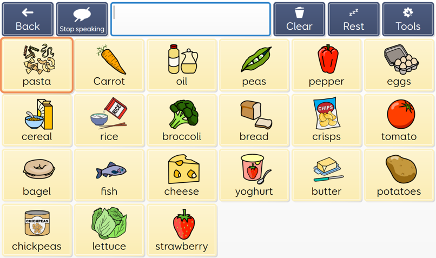
In the above example the student is sorting foods into food groups using word lists to create a labelling activity.
The output phase:
This is the learning phase where the student demonstrates their understanding by answering questions either orally (using their AAC communication pages), by giving short answers to assessment questions (which may be multiple-choice, short written answers or answers using their communication vocabulary). They might also be writing larger pieces of text such as essays or producing a final piece of work, such as a poster, that demonstrates their understanding.
This is the only phase at which a list of words added to communication pages may be partially useful but still not adequate for all the potential output tasks such as building posters, answering multiple-choice question, or writing essays.
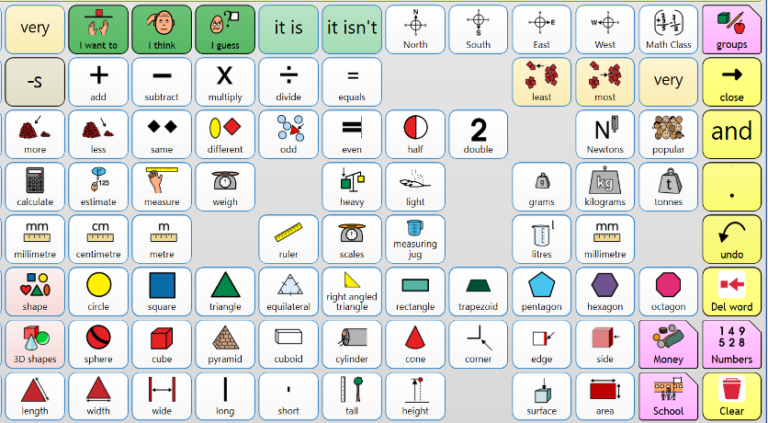
A word list such as this would only enable a student to give one word or very short phrase answers and very basic instructions. It could, however, be useful for short answers to questions in a group discussion.
The grid pages on this page are examples of English assessment materials for students who are at the advanced level or upper formal curriculum level.
Level 3
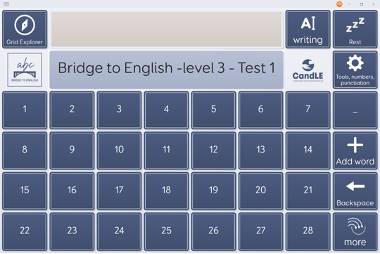
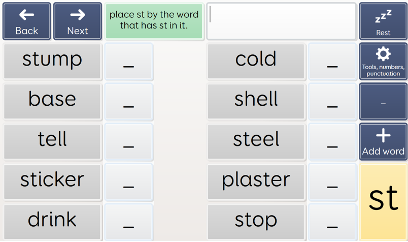
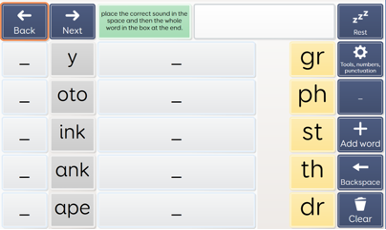
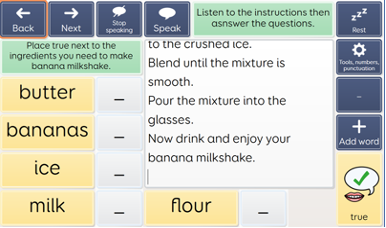
Level 4
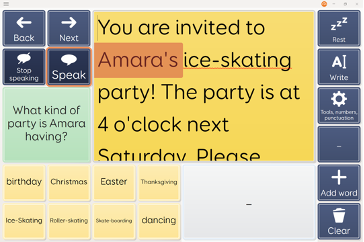
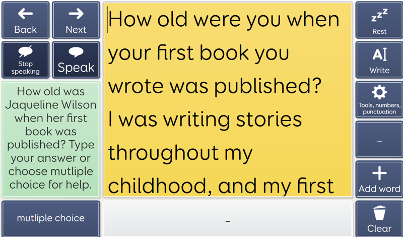
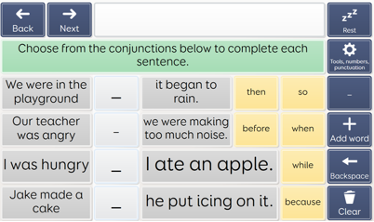
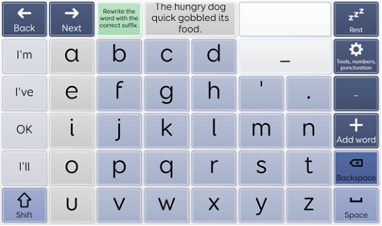
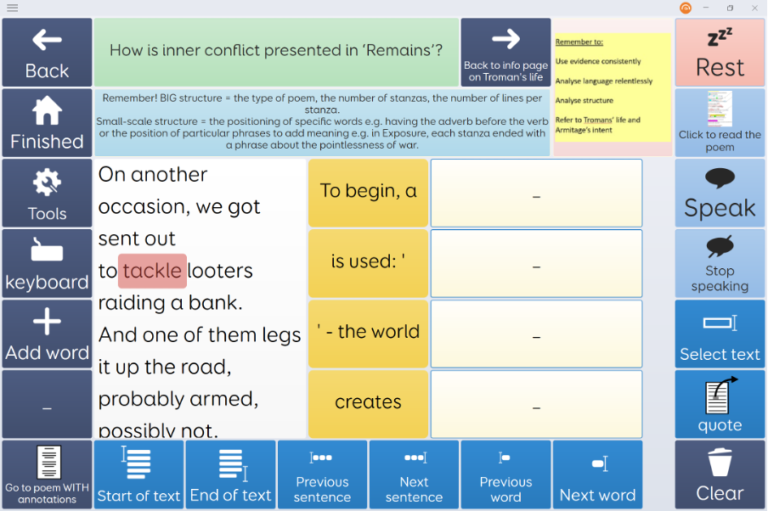
This is a template at GCSE coursework level to support the writing of an essay.
Finally:
When appropriate differentiation and adaptation is provided in a fully accessible way the mainstream curriculum becomes much easier to access as the grids are developed to ensure that the student can keep up with non-disabled peers as near as is possible. Other accommodations may need to be made such as dropping certain subjects to be able to have catch up sessions in the ones the student really wants or needs to study. Another approach might involve learning repetition until learning is solid rather than continuing to repeat even after learning has become solid.
It is important to find the student’s Zone of Proximal Development (ZPD). This is the level of work that a student can complete with some help (scaffolding but not being given the answer) rather than being asked to complete work that they are already confident with. To find a student’s ZPD tests should be carried out that involve helping the students to get to the answer with a record being kept of those questions the student can confidently answer independently, can answer with scaffolding, or cannot answer even with help. The level at which the student can achieve an answer with scaffolding is the level at which the student should be learning.
Marion Stanton PGCE, AAC accredited (Level 7), MA (online and distance education),
Adv. Dip. Ed. (Special), MCCT
Head of Education
